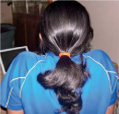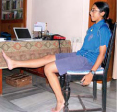Sunita Anand
The feeling of heavy head, tense shoulder muscles, aching back and sore wrist is an oft-occurring phenomenon amongst teachers and people who work at the computer as part of their jobs. Relaxation techniques and exercises that you can incorporate into your workday go a long way in helping you de-stress and enjoy your day! Here are 10 tips I have used, during my years as a teacher and in my current job where I spend long hours at the computer.
The first step in relaxation is deep breathing. Stress and anxiety cause our breathing to become shallow. Take a deep breath. Count to five and then exhale through the mouth again to the count of five. Repeat 5 times.
Head Rolls:

Tuck your chin into your chest and then move your head sideways to the right towards your right shoulder. Make sure you keep your shoulders down. Hold this for a count of 3. Then move your head towards the left shoulder, taking care to keep the shoulders down. Hold for a count of 3. Repeat this 5 times.
Shoulder Shrugs:
 Shrug your shoulders up to your ears and then release slowly. Repeat at least 5 times.
Shrug your shoulders up to your ears and then release slowly. Repeat at least 5 times.
Wrist Rolls:

While keeping your elbows on the desk (forearms perpendicular to the table), make a fist of your right hand. Grab the right hand with your left a little below the right wrist. Now circle the right wrist clockwise 5 times. Repeat the same on the left wrist. This time grab your left hand a little below the left wrist with your right hand and then circle the left wrist slowly clockwise 5 times.
Wrist Release:

Place your elbows on your desk with your palms facing inward. Your forearm will be perpendicular to the table. Make fists of your hands with your thumbs up. Slowly curl your fists outward (at this point your palms will be facing upward) and then in, taking care not to move your forearm or your elbow. Repeat this 5 times. Each outward/inward movement counts as 1 repetition.
Calf Raises:
 While standing at your desk, place your palms on your table and push yourself up to stand on your toes. Take care to maintain a straight spine and relax your shoulders. Hold this position for a count of 5 and then release to return your heels to the floor. Repeat 5 times.
While standing at your desk, place your palms on your table and push yourself up to stand on your toes. Take care to maintain a straight spine and relax your shoulders. Hold this position for a count of 5 and then release to return your heels to the floor. Repeat 5 times.
Ankle Stretches:

Sit on your chair and extend your right leg forward with only the heel of the right foot on the floor. Point the toes of the right foot. This is called extension. Hold this for a count of 3 and then flex the foot. This involves pulling the toes towards the front of the lower leg for a calf stretch, while still keeping the heel of the foot on the floor. Repeat 5 times.
Leg Extensions:
 This exercise builds lower body strength. Sit back in your chair. Sit tall and then extend your right leg in front of your body. At this position your right leg should be parallel to the floor. Hold this position for 3 counts and then try and raise the leg a little higher. Relax and lower the leg. Repeat on the other side. Do this for 5 counts.
This exercise builds lower body strength. Sit back in your chair. Sit tall and then extend your right leg in front of your body. At this position your right leg should be parallel to the floor. Hold this position for 3 counts and then try and raise the leg a little higher. Relax and lower the leg. Repeat on the other side. Do this for 5 counts.
 Side Stretches:
Side Stretches:
Sit back in your chair with shoulders relaxed and spine aligned. Grab your right wrist over your head with your left hand and pull it down towards your left side till you feel a stretch on your right side. Hold for 5 seconds. Return to start position. Now grab your left wrist over your head with your right hand and stretch. Repeat 5 times.
Posture:
 Sit tall in your chair with your shoulders relaxed and your stomach muscles tight. Be conscious not to slouch in your chair. This, along with other core-strengthening exercises will ensure core strength. Once your core is strong (i.e. this includes the muscles of the stomach and back), you will find yourself complaining less about general aches and pains. Above all, listen to the signals your body gives out. Remember any consistent stress or pressure on your joints will cause irritation and soreness in the long run.
Sit tall in your chair with your shoulders relaxed and your stomach muscles tight. Be conscious not to slouch in your chair. This, along with other core-strengthening exercises will ensure core strength. Once your core is strong (i.e. this includes the muscles of the stomach and back), you will find yourself complaining less about general aches and pains. Above all, listen to the signals your body gives out. Remember any consistent stress or pressure on your joints will cause irritation and soreness in the long run.
These 10 tips detailed above do not have to be done at one time. You can pick one or two exercises to be done at a time. You will only need a couple of minutes to finish your exercises. You must make sure to take a break every half hour from your desk to walk around and stretch your contracted muscles. This is the best way to avoid any Repetitive Strain Injuries (RSI).
The author, a former teacher and computer professional, now works in a children’s museum in Chicago, USA. She can be reached at sonyanan@yahoo.com.
Why Yoga Works
Sharmila Hirendernath
Counter to the plethora of seven-step solutions and quick-fix formulas offered by so many contemporary self-help guides including some Yoga teachers, the ancient science of yoga does not pretend to be simple, quick, or easy. It is a practice that takes into account the very messy and often complex phenomenon of what we call a human being and the equally challenging task of everyday living. What yoga does promise, however, is that through sincere, skillful, and consistent practice, anyone can become peaceful, happy, and free. As Swamy Shivananda said, “Health is Wealth, Peace of mind is happiness and yoga shows the way.”
We achieve this in yoga practice by simple means. Through the practice of postures or Asanas we release pent-up tensions that have accumulated in our body, and we further refine our physical senses so that we become sensitive, adaptive, and resilient; simultaneously, we reacquaint ourselves with the cyclic nature of our breath and its relationship to the sensate wisdom of our body. We learn to inhale completely and open up to new experience. We learn to exhale completely and let go of unnecessary tension and the past. And we learn to rest in the pauses in between this arising and dissolving cycle.
Regardless of whether you are a beginner or an experienced practitioner, the moment you engage in yoga practice you will discover that the practice is itself the reward. You start to feel a sense of ease with life, and you feel more able to adapt to change. You experience a new vitality and clarity that affect your relationships at home, at work, and in the world.
There is now a large body of scientific evidence that demonstrates that Hatha yoga is effective in controlling/treating various physical and psychosomatic ailments. A small Scandinavian study that measured brain waves before and after a two hour yoga class found that alpha waves (relaxation) and theta waves (unconscious memory, dreams, and emotions) increased by 40 per cent.
Yoga and meditation can alter the very bio-chemistry of the brain more directly and efficiently than regular exercise. When you do yoga stretching with breath awareness you send a message through the spinal cord back to the brain that causes your body chemistry to change. That “feel-good” sensation after yoga practice arises from the balance of stimulation and relaxation you are providing your brain. You feel more relaxed because your cortisol level drops, and you are increasing oxygen consumption and reducing muscle stiffness and tension. In addition to the relaxation affect documented in studies throughout the world, there is enough evidence that shows that regular practice will result in improvement in memory, cognitive functioning, perceptual motor skills, muscle power and visual perception indicating that a Yoga practitioner is more alert and also able to focus and perform better.
But you don’t take an antidepressant medication just once and expect to feel better. You take it regularly. So with yoga, to restore the body and mind to a steady state of well-being, you must also practice regularly and not expect fifteen-day miracles.
Yoga as part of the workday
Many people have a limited – and often negative – idea about work. Part of the definition of being a teacher, it seems, is someone who is always working. Traditionally, in this country, we take very little time on a regular basis to refresh ourselves in stillness. In yoga, that regular time of stillness is seen as a way to work on yourself; you take time every day to refresh your body and mind with creative thought and experience.
Yoga is a type of work that helps you work; as such, it is needed during work time. Try expanding your definition of work. Give yourself this 20 minute gift every day, and you will be boosting your capabilities by injecting balance and new energy into your life. To derive the real benefit of yoga, it should become a part of your daily routine. If you are unable to motivate yourself to begin practicing yoga on your own, why not start a yoga club at your school, for teachers, and maybe, even for teachers and students?
A 20-minute session before the time-table kicks in, or a half hour at the end of the day might be an entirely possible addition to your routine.
What yoga provides in the 20-minute routine at work is a way to change your thinking. Sometimes, in the middle of the day, you suddenly “surface,” feeling drained, fatigued, wiped out. Minutes or hours have gone by in deep concentration, and you’ve forgotten everything except what you’re working on. At those times, your breath becomes shallower and less and less oxygen gets to your brain. Suddenly you feel almost suffocated. That’s the time to take a break: do some deep diaphragmatic breathing and move around a little to increase circulation so your brain gets some nutrients. At the same time, change your thinking, rattle your brain waves, stimulate the areas of intuition and creativity that may have been pushed aside by all that wonderful logical thinking, and give yourself the gift of some new ideas.

The author is an internationally accredited yoga teacher with about 12 years of experience. She can be reached at shirendernath.yoga@gmail.com.
